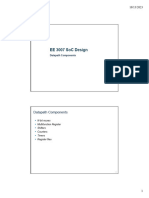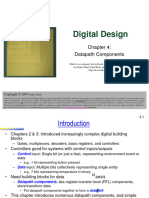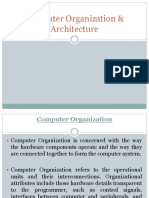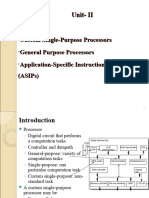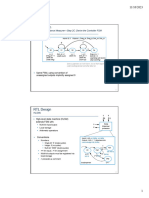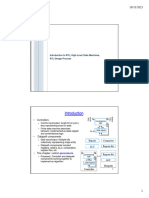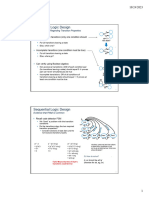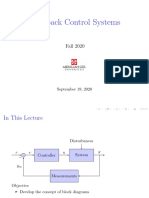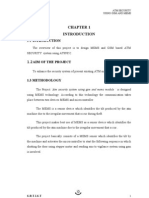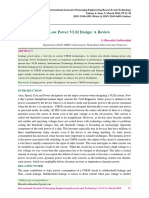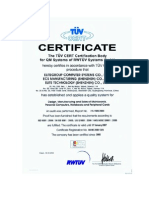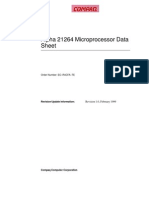10/9/2023
EE 3007 SoC Design
Datapath Components
Datapath Components
N-bit muxes
Multifunction Register
Shifters
Counters
Timers
Register files
1
� 10/9/2023
Datapath Components
N-bit Mux
Example: Two 4-bit inputs, A (a3 a2 a1 a0), and B (b3 b2 b1 b0)
4-bit 2x1 mux (just four 2x1 muxes sharing a select line) can select between A or B
2x1
a3 i0 Simplifying
d
b3 i1 notation:
s0
4-bit 4
2x1 4 C
a2 i0 2x1
d A I0 4
b2 i1 D C is short
s0 4
B I1 for
2x1
a1 i0 s0
d
b1 i1 c3
s0
s0 c2
i0 2x1
a0
d c1
b0 i1
s0
s0 c0
Datapath Components
N-bit Mux Example
From the car's central 8-bit a
computer 8
T I0 4x1
A 8
I1 8 D To the
I 8 D above-mirror
I2
display
M 8
I3
s1 s0
x y
We will design
this later
button
Four possible display items
Temperature (T), Average miles-per-gallon (A), Instantaneous mpg (I), and Miles
remaining (M) – each is 8-bits wide
Choose which to display on D using two inputs x and y
Pushing button sequences to the next item
Use 8-bit 4x1 mux
2
� 10/9/2023
Datapath Components
Registers
N-bit register: Stores N bits, N is the width b x
Combinational n1
Can store data, very common in datapaths logic
n0
Common widths: 8, 16, 32 s1 s0
Storing data into register: Loading clk State register
Opposite of storing: Reading (does not alter contents)
Basic register: Loaded every cycle
a
Useful for implementing FSM -- stores encoded state
For other uses, may want to load only on certain cycles
I3 I2 I1 I0
4-bit register
load I3 I2 I1 I0
D D D D reg(4)
Q Q Q Q
Q3 Q2 Q1 Q0
clk
Q3 Q2 Q1 Q0
Basic register loads on every clock cycle
How to extend to only load on certain cycles? 5
Datapath Components
Register with Parallel Load
Add 2x1 mux to front of each flip-flop
Register’s load input selects mux input to pass
Either existing flip-flop value, or new value to load
I3 I2 I1 I0
1 0 1 0 1 0 1 0
load 2x1
2mux
1 I3 I2 I1 I0
load
D D D D
Q3 Q2 Q1 Q0
Q Q Q Q
Q3 Q2 Q1 Q0
(a) (c)
I3 I2 I1 I0 I3 I2 I1 I0
load = 0
load = 1
1 0 1 0 1 0 1 0 1 0 1 0 1 0 1 0
D D D D D D D D
Q Q Q Q Q Q Q Q
Q3 Q2 Q1 Q0 Q3 Q2 Q1 Q0
(
(b)
6
3
� 10/9/2023
Datapath Components
Shift Registers
Shift right
Register contents
Move each bit one position right 1 1 0 1
before shift right
Shift in 0 to leftmost bit 0
Register contents
0 1 1 0
after shift right
Shift Register
Connect register’s flip-flop’s outputs to
next flip-flop’s input
This design would always shift on every
clock cycle shr_in
How can we control it?
Datapath Components
Shift Registers
What is the result after shifting 10011 four times to
the right?
1. 10011
2. 00010
3. 10000
4. 00001
4
� 10/9/2023
Datapath Components
Shift Register
To allow register to either shift or retain, use 2x1 muxes
shr: 0 means retain, 1 shift
shr_in: value to shift in
May be 0, or 1
Note: Can easily design shift register that shifts left instead
shr_in
shr=1
shr 1 0 1 0 1 0 1 0 1 0 1 0 1 0 1 0
2 1
2 1
D D D D
D D D D
Q Q Q Q
Q Q Q Q Q3 Q2 Q1 Q0
Q3 Q2 Q1 Q0 (b)
(a)
shr_in
shr
Q3 Q2 Q1 Q0
(c)
9
Datapath Components
Rotate Register
Rotate right Register contents
1 1 0 1
Like shift right, but leftmost bit comes before shift right
from rightmost bit
Register contents
1 1 1 0
after shift right
10
5
� 10/9/2023
Datapath Components
Buses
N-bit bus: N wires to carry N-bit data
item
Circuit drawings can become cluttered
ld
Convention for drawing buses
Single bold line and/or small angled line 8
across
a
11
Datapath Components
Register Example: Above-Mirror Display
Instead of connecting car’s
computer to display using 32
wires, can we use fewer
wires?
To reduce wires: Car’s
computer can write 1 value at 0001010
C Loaded on clock edge
a time, loads into one of four 8
registers with display d0 load reg0 T
2-4 decoder i0
8
0 8-bit
d1 load reg1 A
a0 4× 1 Mux
i0
i1
1 i1 8
a1 1 d D
d2 loadreg2 I 8
0001010
i2
8
d3 load reg3
e M
1 i3 s1 s0
load 8
x y
12
6
� 10/9/2023
Datapath Components
Shift Register Example: Above-Mirror Display
Earlier example: 8 +2+1 = 11 wires from car’s computer to
above-mirror display’s four registers
Better than 32 wires, but 11 still a lot -- want fewer for smaller
wire bundles
Note: this line is 1 bit, rather than 8 bits like before
Use shift registers
x y
c
Wires: 1+2+1=4 shr_in
d0 shr
Computer sends one value reg0 T
s1 s0
at a time, one bit per clock
2 4 i0
cycle 8
shr_in 4×1
Serial communication d1 shr reg1 A
a0 i0
i1
a1 i1 8
shr_in d D
d2 shr reg2 I 8
i2
8
shr_in
shr reg3
e d3 M
shift i3
8
13
Datapath Components
Multifunction Registers
Many registers have multiple functions Functions:
Load, shift, clear (load all 0s)
s1 s0 Operation
And retain present value, of course
0 0 Maintain present value
Easily designed using muxes 0 1 Parallel load
Just connect each mux input to achieve desired 1 0 Shift right
function 1 1 (unused - let's load 0s)
shr_in I3 I2 I1 I0
0 0 0 0
s1 3 2 1 0 3210 3210 3210
s0 4 1 shr_in I3 I2 I1 I0
s1
D D D D s0
Q3 Q2 Q1 Q0
Q Q Q Q
(b)
Q3 Q2 Q1 Q0
(a)
14
7
� 10/9/2023
Datapath Components
Multifunction Registers
s1 s0 Operation
0 0 Maintain present value
0 1 Parallel load
1 0 Shift right
1 1 Shift left
I3 I2 I1 I0
shr_in
shl_in
3210 3210 3210 3210
shl_in I3 I2 I1 I0
shr_in
D D D D s1
s0
Q Q Q Q Q3 Q2 Q1 Q0
Q3 Q2 Q1 Q0
(a) (b)
15
Datapath Components
Multifunction Registers with Separate Control Inputs
ld shr shl Operation I3 I2 I1 I0
0 0 0 Maintain present value shr_in
0 0 1 Shift left ld shr_in I3 I2 I1 I0
?
0 1 0 Shift right combi- s1 shl_in
s0 shl_in
0 1 1 Shift right – shr has priority over shl shr national
1 0 0 Parallel load circuit Q3 Q2 Q1 Q0
1 0 1 Parallel load – ld has priority shl
1 1 0 Parallel load – ld has priority Q3 Q2 Q1 Q0
1 1 1 Parallel load – ld has priority
Truth table for combinational circuit
Inputs Outputs Note
ld shr shl s1 s0 Operation
0 0 0 0 0 Maintain value
s1 = ld’shr’shl + ld’shrshl’ + ld’shrshl
0 0 1 1 1 Shift left
0 1 0 1 0 Shift right = ld’shr + ld’shl
0 1 1 1 0 Shift right
1 0 0 0 1 Parallel load s0 = ld’shr’shl + ld = shr’shl + ld
1 0 1 0 1 Parallel load
1 1 0 0 1 Parallel load
1 1 1 0 1 Parallel load
16
8
� 10/9/2023
Datapath Components
Register Operation Table
Register operations typically shown using compact version of table
X means same operation whether value is 0 or 1
One X expands to two rows
Two Xs expand to four rows
Put highest priority control input on left to make reduced table simple
Inputs Outputs Note
ld shr shl s1 s0 Operation ld shr shl Operation
0 0 0 0 0 Maintain value 0 0 0 Maintain value
0 0 1 1 1 Shift left 0 0 1 Shift left
0 1 0 1 0 Shift right 0 1 X Shift right
0 1 1 1 0 Shift right 1 X X Parallel load
1 0 0 0 1 Parallel load
1 0 1 0 1 Parallel load
1 1 0 0 1 Parallel load
1 1 1 0 1 Parallel load
17
